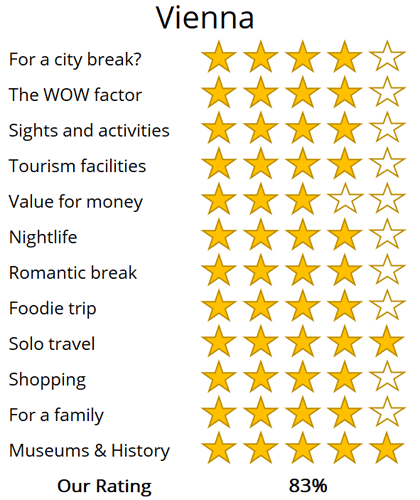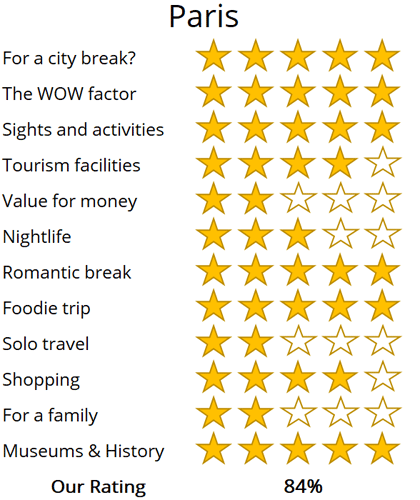WhereToGoForMyHoliday.com
The best destination comparison site!
WhereToGoForMyHoliday.com
The best destination comparison site!
Vienna or Paris a vs city comparison and travel guide
Vienna and Paris both offer unique and enticing experiences, but which one should you choose for your city break or holiday?
We understand your dilemma. There is an abundance of travel guides for both cities, but few actually comparing them, and advising you which is the better for your trip.
This article will provide our unbiased and independent views of Paris and Vienna, hopefully making your choice that little easier.
The article is structured into several sections, each of which can be directly accessed through the following links:
• Introduction to the cities
• Scores and ratings
• Which one should I, friends, or family visit?
• When to visit and weather
• Who is the city suited for?
• The perfect 48hours (with map)
• Tourism details (where to stay? airport details?)
Introduction to Vienna and Paris
The erstwhile epicentre of the great Habsburg empire, Vienna, is just as grand and glorious as you might expect. The Hofburg palace spreads is vast Baroque wings in the heart of the town, framing manicured gardens topped with equestrian statues.
There's the Belvedere, a patchwork of orangeries and old court rooms. There are opera houses and theatre rooms and the elegant façades of the Schönbrunn. It's enough to keep the camera a-clicking for several days.
But Vienna isn't only about 18th-centry grandeur. This is a lived-in European capital. It's got gritty nightlife districts that offer up beating boat bars on the Danube. It's got handsome parks packed with pine forests and duck ponds. There are vibrant markets with food from all around the globe. And you've got one of the world's most active café cultures, with coffee shops where the likes of Freud and Trotsky were once regulars.
Paris is famed as the capital of Romance, the epicentre of French culture and grand European art, and the home of iconic monuments like the Eiffel Tower. There's no question that it's an amazing city to explore.
Everywhere you go along the Seine River it seems like there's a world-class museum or gallery beckoning. But Paris can also be overwhelming, not to mention downright gritty in some parts.
The history here goes back to the Celtic tribes of the 400s BC. But it was the 7th-century fortifications on the Île de la Cité that went on to form the medieval kernel of the town.
The capital still radiates out from that, with bohemian neighborhoods along the Canal Saint-Martin, stereotypically Parisian cafes and cobbled streets in Montmartre, and enthralling cultural and foodie attractions throughout other arrondissements (areas).
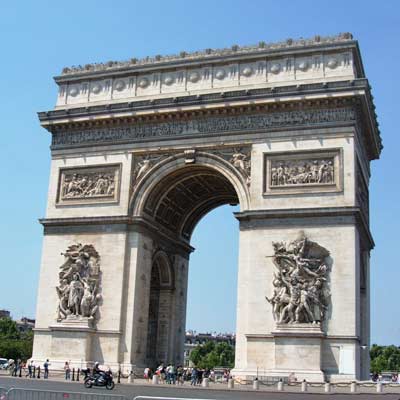
The Arc de Triomphe, constructed as a memorial to the soldiers who perished in the Napoleonic Wars and French Revolution

The classic skyline view of Vienna from Saint Stephen’s Cathedral, with its uniquely tiled roof
Vienna vs Paris: City Ratings
Summary
Where would I journey for a personal escape?
Vienna
Where would I send my parents for a memorable visit?
Vienna
Where's the ideal destination for my adventurous 19-year-old cousin?
Vienna
Where should my food-obsessed friend indulge their culinary passions?
Vienna
Note: The above comparisons are weather-independent and are based on travel during the most opportune times of the year. Details about the ideal travel seasons are elaborated upon later in this article.
In the sections that follow, you'll find a comprehensive comparison between these two fascinating cities. This includes recommendations on the duration of stay, the best times to visit, and tailored 48-hour itineraries for each city.
The final segment delves into practicalities for your travels, such as the best airport to fly into, the optimal districts for your accommodation, and insider tips, for when you come to explore the city.
We hope that you find all of this information useful, in planning your next exciting trip!
Destination details
How long to spend each city?
Paris could take a lifetime to explore completely. This is a living, breathing, sprawling capital city, which means even the locals can be surprised at the new cafes, bistros, and cultural events that come and go. For travellers, at least three days is a good idea.
That's probably just enough to see the mainstay sights and hop into the Louvre to catch a glimpse of the Mona Lisa. Trips to explore outer arrondissements and sample Paris's pumping nightlife should probably be between four days and a whole week, with more extensions needed if you want to hit the Loire Valley for wine tasting.
Vienna is big and brimmingwith sights. History buffs and culture vultures will want at least three or four days to check off the bucket-list attractions. That's because the mainstay palaces and the most immersive museums each deserve at least half a day to themselves. You'll also need some time to wander the Old Town area and hop the famous Viennese cafés.
If you're eager to explore all of the facets of Vienna, then you'll certainly need much longer than just your average city break. Whole weeks can be spent enjoying the buzzy squares and the statue-filled parklands. What's more, there are day trips aplenty in the region, ranging from the pine forests of the Wienerwald to the rising foothills of the Salzburger Alps.
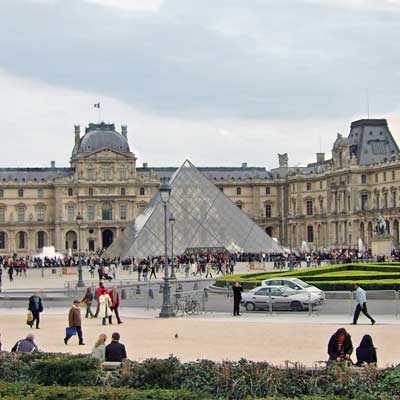
The Louvre with its distractive glass pyramid

The Schönbrunn Palace, Vienna one of the grandest palaces of central Europe
Vienna in the summer can't be beaten. When the sun shines, the city's parks and bars come alive. The best weather is usually between June and August, but beware that things can get hot and humid, with temperatures cranking up over 30 Celsius. The good news is that there are some strands and swimming spots along the Danube for cooling off. If you prefer things a little milder, May and September are usually also dry and warm.
On the flip side, Vienna in winter is a real wonderland. The Austrian capital hosts some of the most enchanting Christmas markets in Europe. You'll find those brewing up hot chocolates and mulled wine on Rathausplatz and in the grounds of the Schloss Schönbrunn. They get into full swing in December, when it's common to get dustings of snow and sub-zero temperatures – boots and woollies will be required.
Paris is known for its café culture, it would be a shame to miss all those al fresco coffees on the canal side. Enjoyments like that are most likely to be had in the warmer months, which – this far north in France – means May to September.
Outside of those, the rainfall picks up and things get chilly. That said, the summer is the most expensive and busy part of the year, so you'll be contending with others for those selfies by the Eiffel Tower.
Visits pre-Christmas tend to be pricier than those after Christmas. If you're eager to cosy up and see Paris in the ice and cold, you might want to push your break to February or March. Those months tend to be nice, quiet and free from the tourist masses.
Paris is a master of art and culture. From the gold-gilded palaces of Versailles to the endless works of the Louvre and the Musée d'Orsay, you'll never be short on paintings or architecture or sculpture.
But the best Paris trips mix all that with a little bit of food, some classic sightseeing, and even a touch of hedonism. That makes this a versatile city-break option, offering wine bars and bucket-list attractions like the Eiffel Tower.
It's probably worth dodging Paris if you're not the sort who deals well with crowds, traffic, and big cities. The nearest place you can go to escape to nature are the forest parks on the outskirts. What's more, it can take a while to get from A to B in the French capital.
Packing in handsome palaces, Austrian beer houses, Alpine forests, cool cafés, art-filled galleries, and a buzzy nightlife, Vienna satisfies all sorts of travelers. You can easily fill whole trips in the museums alone. Days can be whiled away flitting between coffee shops. Nights can be spent in opera shows or glugging frothy beers in hipster bars.
Don't go thinking that Vienna is the great Austrian outdoors. This might be the country of the Alps, but the mountains are still at least an hour's train ride to the west. What's more, there's not a beach in sight. The best that landlocked Central Europe can offer in the way of sand and water is a few artificial swimming areas along the River Danube.

The cascade fountain at the Belvedere, Vienna
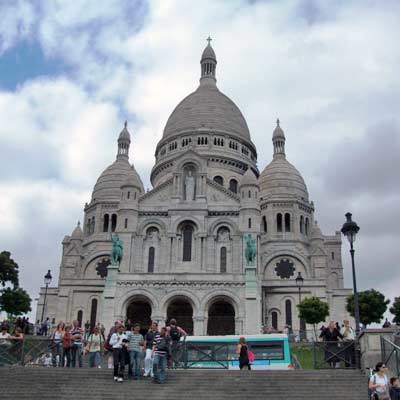
The Sacré-Cœur provides one of the finest view of Paris
48hours in Vienna
So, you only have two days in the Austrian capital? Get ready for an itinerary that's packed to bursting with all sorts. From Neo-Classical Habsburg mansions to strolls on the Danube canals to mornings in buzzy market areas, there's something for a whole host of traveler types in these parts.
Day 1: Morning on the Heldenplatz. This manicured urban garden is one of the most iconic squares in Vienna. The huge equestrian statue of Archduke Charles of Austria is what will probably catch the eye but remember that the plaza was also the place where Hitler announced the annexation of Austria in 1938. Nearby, the Hofburg stands proud.
On a quick, two-day itinerary, it's probably best not to delve inside. The exhibits can easily take hours on end, though it's a must if you're a lover of 18th-century European history. Take your photos of the mighty Neo-Classical exterior and then move straight to the streets to the west. They herald the Innere Stadt (the Old Town) of Vienna. Cobbled lanes and little archways form a maze here that's lovely to get lost in. A lunch stop (read: strudel stop) at Café Central is a doozy. Gold-leafed ceilings and elegant royal portraits gild the interior, though the main draw is sitting where Freud and Trotsky once sat sipping their coffees.
Later on, head north around the ring roads to the Sigmund Freud Museum. It's a fine introduction to the life and works of the founder of psychoanalysis, with the original doctor's couch that his patients would sit on. Beeline straight to Prater when the evening closes in. You can get there on the underground, emerging into Vienna's famous inner-city theme part with its twirling Ferris wheel and fairground attractions.

The Prater amusement park with its traditional rides and the Wiener Riesenrad Ferris wheel
Day 2: The early hours on the Naschmarkt offer some of the best people watching in the city. Fruit sellers call out prices while locals chow down on pretzels and white beer in the stalls. This vibrant bazaar is also the perfect place to grab any Viennese souvenirs and foodstuffs. A ubiquitous fix of palaces comes next. We'd recommend choosing one of the big two – the Belvedere Palace or the Schönbrunn. Both are stunning but the former is the easiest to get to. Both will also likely take a couple of hours, especially if you want to explore the sprawling grounds as well as the interior court rooms of the old Habsburg elite.
That will still leave some time in the afternoon to breeze over to the Danube Canal. Abuzz with boat bars and hole-in-the-wall eateries, it can help balance out the culture with a little hedonism. The district of Leopoldstadt is right behind, replete with hipster coffee joints and cocktail emporiums. An alternative way to cap off your weekend could be a jaunt to the hills of the Vienna Woods (the Wienerwald). They offer lookouts – and gorgeous sunsets – above the capital just behind the area of Hütteldorf.

Vienna is not just historic relic, there are modern curiosities such as the Hundertwasser House, designed by an artist who wished no straight lines in his building......
Paris in 48 hours is a hard ask, but this itinerary should help distil the city's preeminent culture, art and atmosphere into two short days:
Day 1: Breakfast time in the 19th arrondissement. Local and traveller joints meet there, with some charming cafés and bakeries lining Le Bassin de la Villette, where there are open-air swimming spots in the summer months. Then, move south-west along the picturesque Canal Saint-Martin.
It takes you to the beating heart of the city, just shy of where the Île de la Cité hosts the beautiful Cathedral of Notre Dame. Take your photos and then move across the Seine River to the famous Latin Quarter.
It's the perfect place to explore in the afternoon, with boutique bookshops and atmospheric cafés aplenty. For the afternoon, cross the water again and duck into the Louvre Museum.
The morning rush should have subsided, so you can wander the exhibition rooms in search of the Mona Lisa and the Venus de Milo without having to jostle with too many. In the evening, return westwards to hipster Belleville. This district is one of Paris's Chinatowns, with more noodle shops and dim sum outlets than you can shake your guidebook at.
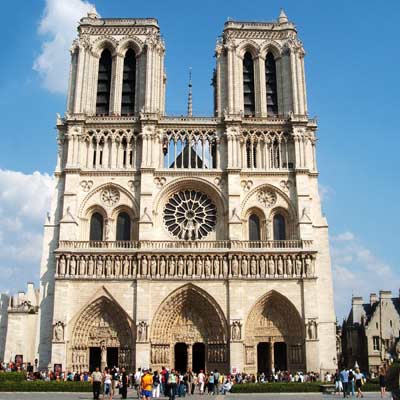
Notre-Dame
Day 2: Seek out the bohemian neighborhood of Montmartre to start your second day in Paris. It's known for its zigzagging cobbled streets and urban staircases, but also comes replete with cosy coffee houses with crispy croissants. At the very top of the hill where the district is draped is the gorgeous Sacré-Cœur. Its great travertine domes gaze over the city, so expect some awesome views.
On the way down, heading west, you might just pass by the infamous Moulin Rouge and its makeshift windmill all lit up in red neon. You can catch a metro from that to go along to Ternes. Emerge and you'll be looking straight down at the Arc de Triomphe, which marks the start of the Champs-Élysées – a place to shop till you drop.
Be sure to pull yourself from that grand boulevard with enough time (and light) left to see the Eiffel Tower in all its glory. The landmark is just over the river to the south, but the best view might be from the Trocadéro Gardens on the northern banks.
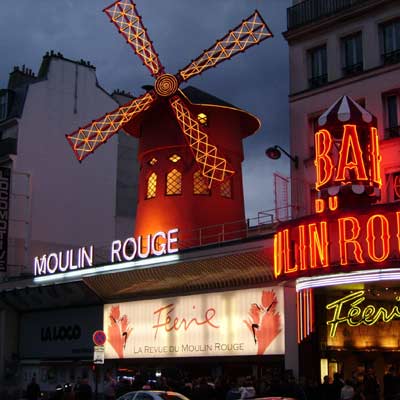
The Moulin Rouge
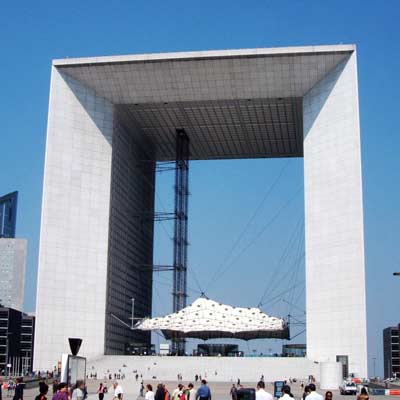
La Défense is the modern side to grand Paris
Paris is served by two large international airports. Low-cost carriers typically use Orly. From there, you can hop to Anthony Train Station and then switch to the urban metro line to reach the city. The trip costs around €12 in total. The more famous and larger airport at Roissy Charles de Gaulle is for long-haul fliers and premium services. It's linked straight to the Gare du Nord station in the middle of the city by regular trains that take around 35 minutes from terminal to town.
Choosing the right area to stay in Paris is important because each arrondissement has its own distinct vibe. You can pay extra and be somewhere like Grenelle and the 7th, where you're most likely to open your hotel window and be gazing at the Eiffel Tower. Or, you can opt for a B&B somewhere like the Canal-Saint Martin – a vibrant, student favourite – or in the 11th arrondissement – cheaper and more lived-in.
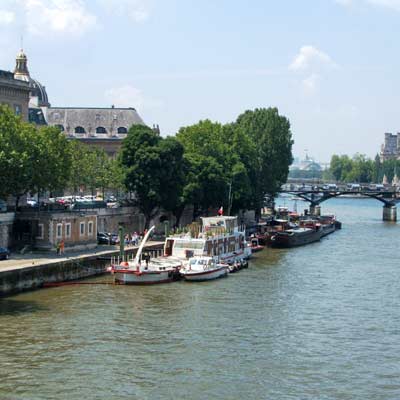
The Seine River meanders through the centre of Paris
The Parisian transport network is vast and efficient. Travelers shouldn't need more than the RER and Metro combination. They can be caught to virtually all the major sights and areas around the capital. You can purchase a contactless card ticket to travel on all the lines – tariffs are €1.90 per ride.
Even among the French themselves, the Parisian people are renowned for being curt and a little rude. Remember that this is a working, living metropolis, so expect central areas to be busy with commuters and the like. You'll also want to be especially cautious on public transport when carrying large luggage or travelling at night, because pickpocketing and thefts certainly aren't unheard of.
Vienna is among the safest and most liveable cities in the world – at least if the stats are to be believed. Of course, you'll need to have your wits about you as if you were traveling anywhere. Pickpocketing, fake tour guides, and taxi scams do occur, though they aren't common as in other European capitals.
Getting around should be a cinch in the Austrian capital. The U-Bahn is ridiculously efficient. It links with above-ground rail lines and trams on a single-ticket network to make going from A to B a pleasure, not a chore.
Single trip fares sit at €2.40, while a 48-hour travel card costs €14.10. Don't be tempted to ride the subway without buying tickets. This is possible because the platforms aren't gated, but there are regular checks and hefty fines to match.

The Gloriette is situated on one of the highest points of Vienna and provides one of the best views of the city and the Schönbrunn Palace.
The best arrival point for those flying is Vienna International Airport. It's a well-equipped, modern port on the south-eastern side of the capital. Direct S-Bahn trains link the centre to the terminals, or you can hop on the premium Railjet from Vienna Hauptbahnhof. There's also a shuttle link provided by AirportLines Bus, costing €13 per person, return.
Picking hotels in Vienna can sometimes be a tricky business. First-time visitors can't go wrong if they aim to stay in the Old Town (the Innere Stadt), but rooms there can be pricy and sell out fast. Good alternatives include the hip and happening district of Leopoldstadt (great for dining with a youthful vibe) and any of the blocks that come off Naschmarkt.

oh we were stuck in the airport!

Copenhagen was a bit expensive...

All we did was drink beer in Brussels...

Muncih was crazy

And we got so burnt!

Remeber that night in Rome

oh we were stuck in the airport

So much fun kayaking

Berlin and that group from Austria!

There was such a view from that church

And we got so burnt!

Munich was eventful, wasn't it!

Such a view from that cathedral in Florence

Lisbon was such so much fun

Last summer was so much fun .... x

Remeber that night in Rome

Lisbon was such so much fun

Such a view from that cathedral in Florence

Munich was eventful, wasn't it!

And we got so burnt!

Remeber that night in Rome

All we did was drink beer in Brussels...

Berlin and that group from Austria!

Can't wait to go back to Dubrovnik

Remember that boat ride in Prague

Copenhagen was a bit expensive...
